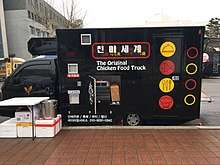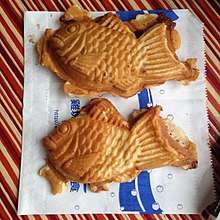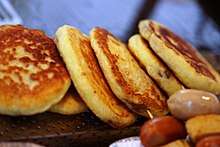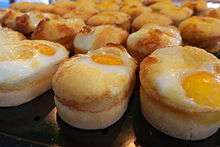Street food in South Korea
Street food in South Korea has traditionally been seen as a part of popular culture. Historically, street food mainly included foods such as Eomuk, Bungeo-ppang and Tteok-bokki. Street food has been sold through many types of retail outlet, with new ones being developed over time. Recently, street food has seen a popular resurgence in South Korea, such as at the Night Market at Hangang Park, which is called "Bamdokkaebi Night Market"(밤도깨비야시장).[1]
History
There are many kinds of traditional street food in South Korea. For example, glutinous rice cake (called Chapssal-tteok) with buckwheat jelly, Bbopgi which is a Korea traditional ice cream, a fish shaped bun with bean jam called Bungeo-ppang, roasted sweet potato, and Chinese pancakes with brown sugar filling (called Hotteok). The traditional street foods are most common in the winter season; in the summer season ice cream is more popular.[2]
In the Joseon Dynasty street vendors began to form a base of economic activity in the low-income bracket around markets. After the Korean War street vendors prospered by serving refugees and the large numbers of U.S. troops. Street food's influences come from the Cheonggyecheon Stream, Itaewon, and Jongno districts. Street food has become an important part of food culture in South Korea.[3]
Contemporary development
In the past, hotteok, fish cake skewers, a fish-shaped bun, and other snack foods were usually street food. Nowadays jokbal, steak cubes and jajangmyeon are served as meals. So street food is sometimes referred to as a "moving restaurant."
There are issues with street vendors. First, there are concerns with the hygiene of street food, although street vendors have tried address this issue.[4] Secondly, street vendors do not usually pay tax; although after government promises of financial assistance the vendors made a commitment to pay taxes, for example in Noryangjin district. A third issue relates to selling by squatters, usually elderly people, in subway stations, where it is illegal.[5]
Street food in South Korea has become gentrified and diverse,[6] much like other regional or national foods, for example: Chinese Tanghuru, Kebob's, Turkish ice cream, Chilean Churros, etc. Food ordered is served within 2–3 minutes. Street foods are intended to be visually appealing as well as delicious, and the preparation can be an entertainment in itself, for example watching a vendor's hands as they roast the ingredients on an iron plate.[7]
There are some festivals related to street food: for example, the Night Market at Hangang Park and university festivals. In addition, with the advent of the steak cube, an era of luxury street food has begun.[1]
Forms of street food
- Food truck: Recently, food trucks have become a new trend in food culture. In Korea today, the food truck is a popular purveyor of street food, prevalent in parks and culture-art spaces.[8]


- Food bike: It is called a food bike because food is sold from a bicycle; pedal propelled, or motorised ifa tricycle. This is new in Korea and it is planned to exhibit the first prototype in Gyeonggi-Do, and conduct a trial run. [9]
- Pojangmacha: A pojangmacha is a small tented spot that can be on wheels or a street stall in South Korea that sells a variety of street foods, such as hotteok, gimbap, tteokbokki, sundae, dakkochi (Korean skewered chicken), odeng, mandu, and anju (dishes accompanied with drinking). In the evening, many of these establishments also serve alcoholic beverages such as soju.[10] Pojangmacha literally means "covered wagon" in Korean.[11]
Popular street food places
Traditionally street food was only seen at markets or on crowded streets, but it is now more widespread. In some regions dedicated street food streets have been built.
Busan: Kkangtong Market was the first permanent night market in South Korea. There are a lot of exotic street foods. You can taste fusion rice ball with Japanese pork and kimchi, Vietnamese deep-fried dumplings, mie goreng which means Indonesian fried noodles, and so on.[12]
Myeong-dong: Myeong-dong is very popular for street foods. From traditional food such as chicken skewers to unique new concepts of food such as deep-fried blue crab, grilled scallops and more. The street food of Myeong-dong has become famous. Most foreign tourists who visit Myeong-dong make have their meals at the stalls. There are 200 stalls in Myeong-dong, half of which are food stalls.[13]
Noryangjin: Noryanjin's street food is formed around exit 1 of the Noryangjin (Subway line 1) where many street vendors gather. At lunch time this area is crowded with students. Recently Noryanjing has become popular with tourists after publicity on social media started by international students.
Examples of South Korea street foods
| Bungeoppang | This fish-shaped bun filled with sweet red beans is a classic street snack. It is known to have come from Japan in the 1930s. Taiyaki which was famous in Japan became our Bungeoppang. In Japanese, "Tai" means sea bream, and "yaki" means roasted. So this is a cheap street snack which imitates the more expensive Japanese food. It was the most common street food in the 1950s and 1960s, after the Japanese colonial period. It has appeared again since the 1990s.[14] |  |
| Eomuk | Fish cake is a mixture of fish meat and wheat flour. The hot sauce flavored with soy sauce can be addictive to many. Eomuk is also a typical Japanese food. It used to be called oden; Japanese oden is boiled tofu, fish cake, konjac, jelly, and boiled egg on a skewer. It was after the time of enlightenment in 1876 that the eomuk tang (fish cake soup) was brought to Korea. It entered Korea at the port of Bu-san and became a widespread Korean street food. As the home of fish cake history, Busan boasts that its fish cake is the best in Korea.[14] |  |
| Hotteok | Hotteok is a traditional street food in South Korea. It is commonly eaten in the winter. Normally, hotteok is made of dough filled with cinnamon-flavored raw sugar. Nowadays, there are varieties of hotteok with nuts like peanuts. or a colored hotteok with green tea powder and corn flour.[15] |  |
| Hoppang | Hoppang means steamed bun in Korean. A steamed bun is made from flour, usually from the United States, and red beans. Ingredients such as vegetables, meat, sweet pumpkin, curry and pizza are added, and additional variants on the hoppang theme are constantly being developed. It can be found both on the street and at convenience stores.[14] | .jpg) |
| Tteokbokki | Tteokbokki is stir-fried rice cake, a traditional Korean food. There is a history of food similar to tteokbokki in a book called '食療纂要' compiled at the time of Chosun, Sejo in 1460. Before kochujang tteokbokki, there was food similar to tteokbokki in the old court. In the 1800s cookbook "是議全書", there is a record that "I ate white rice cake with beef sirloin, soy sauce, onion, rice cake and so on." It re-emerged in the late 1960s, with a Kochujang (red chili paste) sauce. |  |
| Gyeran-ppang | Gyeran-ppang (egg bread) is a warm street snack sold throughout South Korea. The fluffy, oblong-shaped loaf of bread is sweet and savory with a whole egg inside the pancake dough. |  |
| Dak-kkochi | Dak-kkochi, called Korean chicken skewers, is a popular South Korean street food consisting of small pieces of chicken and scallions grilled on a skewer. | _(10585858164).jpg) |
See also
References
| Wikimedia Commons has media related to Street food in South Korea. |
- 1 2 "서울밤도깨비야시장" [Seoul Bamdokkaebi Night Market]. 서울밤도깨비야시장. Retrieved 2017-06-18.
- ↑ "길거리음식의 강자 '김떡순'이 언제부터 거리를 점령했나" [The strong of Street food 'Kim-Tteok-Sun']. 2014-11-06. Retrieved 2017-05-02.
- ↑ "맛보면서 즐기는 '길거리음식 대동여지도'" [all of street food].
- ↑ "[국민 통합 이야기(14)]-서울 동작구 노량진 컵밥가게 특화거리" [Street of Cupbob in Noryangjin]. 미디어펜 (in Korean). 2017-03-09. Retrieved 2017-05-02.
- ↑ "인정과 불법 사이 '지하철 불법 노점상'" [Between approval and illegal 'illegal street vendor in subway stations']. 2017-05-20.
- ↑ "한 달 매출이 1억 원…길거리 음식의 '고급화'" [Gentrify of street food]. SBS. 2015-05-23.
- ↑ "여행의 白眉, 길거리 음식 탐방 ③노량진" [hot place of traveler of Korea, Noryangjin]. Retrieved 2015-01-27.
- ↑ "요리 경연, 문화 공연…푸드트럭이 거리문화 바꾼다" [Cooking contest, Cultural Performance... Food truck changes Street culture]. 2016-08-30.
- ↑ "길거리음식 파는 자전거 푸드바이크 아시나요" [Do you know 'Food bike' which sells Street Food?]. 2017-04-06.
- ↑ Goldberg, Lina "Asia's 10 greatest street food cities" Archived 2012-03-25 at the Wayback Machine. CNN Go. 23 March 2012. Retrieved 2012-04-11
- ↑ Elisa Ludwig (Mar 14, 2007). "Pojangmacha". citypaper.net. Archived from the original on March 22, 2007.
- ↑ "'부산야시장'에 가면 꼭 먹어야 할 '길거리 음식' 10가지" [Street food in Kkangtong night Market]. 인사이트 (in Korean). Retrieved 2017-05-22.
- ↑ Baek, Jonghyun (2015-12-30). "[시티맵] 길거리 음식, 수두룩 … 맛있는 명동, 후루룩" [Many street food in Myeong-Dong].
- 1 2 3 "'붕어빵, 호빵, 어묵' 겨울철 길거리 간식, 언제부터 먹었나?" [Street food in winter]. Retrieved 2017-05-22.
- ↑ "[추워지면 당기는 길거리 음식] 호떡과 붕어빵" [Street food reminiscent of Winter Hotteok and Bungoppang]. Retrieved 2012-11-29.
